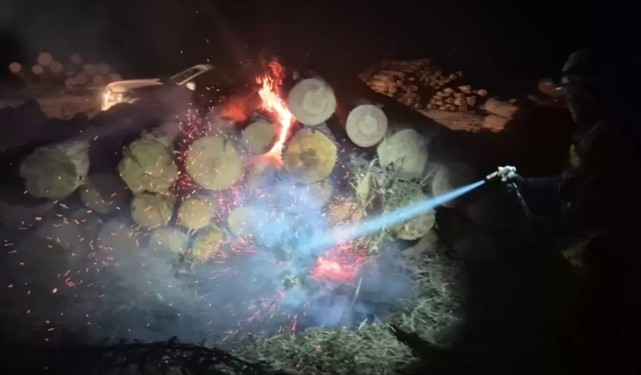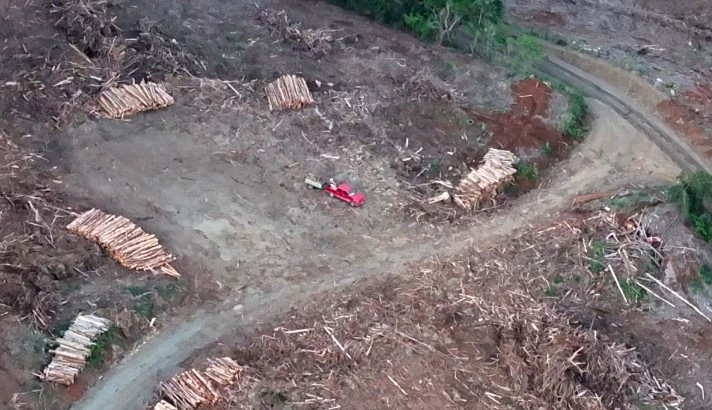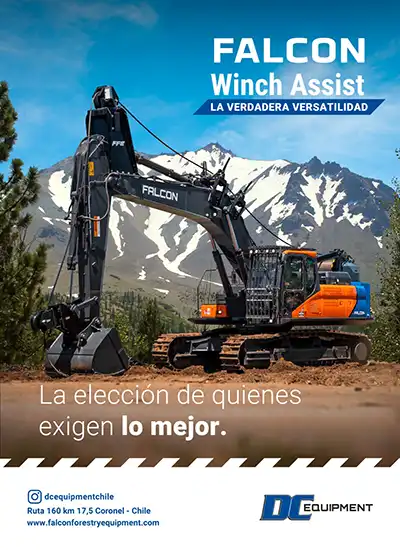Chilean Evidence on Plantations and Water Availability
A series of studies by the Environmental Hydrology Technology Center at the University of Talca have shown that native forests and plantations do not exhibit significantly different hydrological behaviors. However, further research is needed to ensure productive and environmental certainty.
There is growing concern about water in the global context of climate change and the local context of ongoing drought, to such an extent that it will be a topic addressed in the drafting of a new constitution in Chile. According to figures from the former Presidential Delegation for Water Resources of the Ministry of the Interior (2015), water accounts for about 60% of Chile's GDP because it underpins the entire productive framework of agriculture, mining, forestry, tourism, and more.
We discussed water availability in our territory and its relationship with forested areas with Dr. Roberto Pizarro, a Forestry Engineer and Director of the Environmental Hydrology Technology Center at the University of Talca: "When we talk about water, it is not just a productive and economic factor; water sustains our ecosystems, meaning it has environmental value and must include an equity component in its distribution. This is because water distribution in Chile is inherently unequal from north to south, with vast differences, and the same applies from the mountains to the coast."
The Relationship Between Water Consumption and GDP
"From 1990 to today, water consumption in Chile has increased by 3.5 times due to higher agricultural and mining exports, tourism development, and domestic goods and services. All these require water, and there are also environmental demands from those seeking to preserve ecosystems. So, as we’ve grown richer, our water consumption has risen proportionally—our GDP has also grown 3.5 times to date. The engineering conclusion: there is a crucial correlation between economic growth and water consumption. The question then is: Is this equation sustainable in the future? The answer is no, we cannot maintain this scenario. The future demands a different vision." —Roberto Pizarro, Director of the Environmental Hydrology Technology Center at the University of Talca
Water Uses: Consumptive and Non-Consumptive
Water uses are classified as consumptive and non-consumptive. Non-consumptive use occurs when water is used and immediately returned to the source, such as in hydropower. Hydropower does not consume water; it passes through turbines, generates movement, and returns it to the source with a change in elevation.
On the other hand, consumptive use involves water being consumed. Agriculture accounts for the highest consumptive use at 70–72%. According to Pizarro—lead author of 21 specialized books, 8 under UNESCO’s imprint—roughly, as of 1995, each Chilean consumes an average of 15,000 liters of water daily. "You might wonder where those 15,000 liters go. Nearly two-thirds are for electricity generation; of the remaining 5,000, 4,000 are for irrigation, followed by around 700 liters for industrial uses, including agroindustry, forestry, steel, and more. Chileans consume 200 liters daily for personal use and 100 liters for other purposes. These 15,000 liters per day are among the highest in Latin America."
But Roberto, do we have enough water? We’re consuming three times more, yet we have some of the largest freshwater reserves in Southern Ice Fields, alongside Antarctica and Greenland.
Globally, Chile ranks 24th in water availability, averaging 54,000–57,000 m³ per capita annually. The global average is 6,500 m³ per capita, so we have nine times more. But our problem, like in the economy, is distribution. From Santiago northward, the average is 1,000 m³ per capita—less than one-sixth of the global average. UNESCO states that the minimum for human survival is 1,700 m³ per capita annually, meaning northern Chile is below subsistence levels, while the south has an abundant supply. Our country is unequal not only north to south but also east to west.
Another issue is that water supply often arrives abruptly through floods or heavy surges. Conversely, we face drought periods. A key problem is Chile’s lack of strong scientific research on water, something I’ve raised repeatedly in congressional committees.
Chile allocates 0.38% of GDP to scientific and technological research—far below the OECD average of 2.5%. Finland, a forestry-based country, invests 4.5% of its GDP in education and R&D. And how much do we invest in water research? 0.002%. Our problem is ignorance about how ecosystems function. We conduct narrow, specific studies and extrapolate conclusions nationally, which is unfair and inefficient, leading to policies that ignore regional singularities.
A network of research centers competes for dwindling resources yearly, all lamenting the same: no funding for research, no concrete answers. These centers rely on external grants, as universities generally don’t contribute. Research survives only if competitive funds are secured, fostering competition over cooperation among centers.
As a country, we’ve been highly competitive, but our competitiveness hinges on hoping others fail—a harsh free-market approach. I believe we can remain competitive through collaboration, as resources are scarce and efficiency is key.
Is there an investment deficit from academia and public policy? How is the private sector behaving?
The 0.38% for R&D comes from the state; the private sector lags. An exception is Arauco’s Bioforest, a private forestry research group with PhDs conducting R&D. Such research is vital—knowledge leads to coherent public policies.
Take Arizona, USA, where groundwater management is clear due to research-driven policies. This virtuous cycle explains why some nations prosper—they invest in R&D. Chilean hydrological research centers are underfunded, forcing competition for scarce, often mismanaged resources.
You mention Arizona. Here, Juan Sutil’s proposed "water highway" to transport water from south to north is debated. What’s the issue?
First, knowledge gaps: proponents claim they’ll take "surplus" water, but who defines what’s surplus in quantity and quality?
Chile’s mountainous terrain means groundwater recharge occurs mainly in riverbeds, as water flows rapidly. Only soil-vegetation systems can retain it. Winter rains dominate, so infiltration must recharge aquifers for summer use. Why do rivers flow despite drought? Because of stored groundwater from deep infiltration.
Winter floods widen riverbeds, often in aquifer recharge zones. Extracting "surplus" water upstream could disrupt groundwater balance and summer availability. Without full project details, I’d strongly oppose it due to potential environmental harm.
A marine route might work if ecosystems are protected, but upstream extraction could disrupt water supply, biodiversity, and regional sustainability. We must understand our basins thoroughly.
A Bioforest study using isotopes in small basins (3–4 km²) found groundwater takes over 10 years to resurface. Last year’s drought flows came from stored basin water. We need precise data on aquifer dynamics—a national challenge.
The Relationship Between Water and Forests
The link between water availability and forests—native or plantations—is broad and heavily debated, a focus of Pizarro’s research center.
In 2005, a Fondecyt project in the Maule’s Purapel River basin compared degraded native forest replaced by pine plantations. The hypothesis was that native forests managed water better, but data showed similar hydrological behavior. Published in the Journal of Hydrology (2005), this challenged assumptions.
A 2013 study across 42 national basins, comparing official data with forest coverage, again found that forested areas—regardless of type—improved water redistribution.
"We believe plantations don’t consume more water; native forests and plantations behave similarly hydrologically. But more research is needed. There’s no conclusive proof that plantations or forests reduce water availability." Chile’s Mediterranean climate means winter rains coincide with vegetation dormancy, minimizing consumption.
Pizarro contrasts the eroded 1880 Malleco Viaduct area—once like the Atacama Desert—with today’s landscape. Plantations helped redistribute winter rains, recharging aquifers. Vegetation retains water during dormancy, preventing rapid runoff. Large-scale studies are essential—small basins can mislead.
The center’s publication "Forest Mass and Water Availability" (http://ctha.utalca.cl/publicaciones.html), co-authored by leading hydrologists, explores this relationship. "We’re on the right path—initial hypotheses were disproven, showing no significant difference between native and plantation roles. But biodiversity and territorial impacts remain unanswered."
Plantations and Land Management
Pizarro highlights land-use planning: "The Maule’s Andes aren’t ideal for plantations—native forests offer biodiversity, pharmaceuticals, and ecology. But we need plantations for timber, furniture, and pellet fuel (a low-emission winter heating solution). Erosion control is another benefit—pine plantations stabilize soil, preventing sediment damage to irrigation and aquatic ecosystems. Managed wisely, plantations can transition to native forests or remain productive."
"We must balance production and environmental options for national sustainability—energy efficiency, timber production, and biodiversity preservation. Forestry engineering has the tools; public policies should align."

















